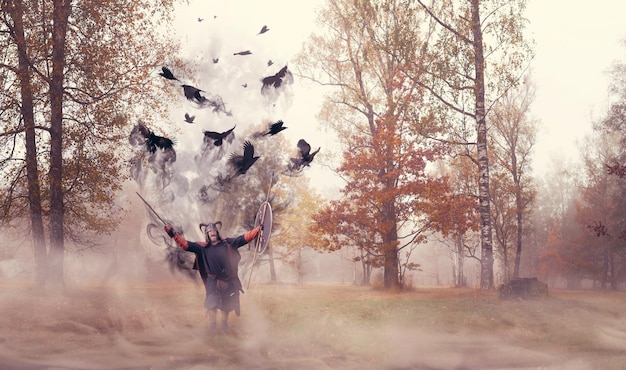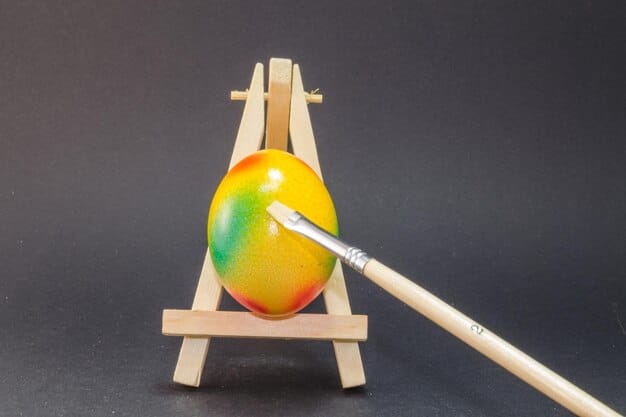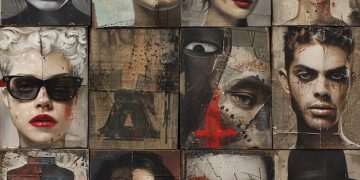Cult Classic Crossovers: Beloved Franchises Collide

Cult classic crossovers explore the creative intersection of two cherished franchises in fan fiction and art, where enthusiasts imagine and depict exciting scenarios when their favorite characters and storylines collide.
Imagine a world where the crew of Star Trek’s Enterprise encounters the quirky inhabitants of Twin Peaks, or where the heroes of Buffy the Vampire Slayer team up with the protagonists of Fight Club. This is the world of cult classic crossovers, where beloved franchises collide in fan fiction and art, sparking creativity and celebrating the unique appeal of each series.
Exploring the Appeal of Cult Classic Crossovers
Cult classic crossovers have become a popular phenomenon within fan communities, offering a unique way to explore and celebrate different worlds. These crossovers often involve beloved characters from distinct franchises interacting in imaginative ways, giving fans a space to expand familiar narratives.
The appeal lies in the unexpected combinations and fresh takes on well-known stories, allowing fans to engage with their favorite characters in new and exciting contexts. Let’s delve into why these crossovers resonate so strongly with audiences.
The Allure of the Unexpected
One of the primary reasons cult classic crossovers captivate audiences is the element of surprise. When franchises with distinct tones, settings, and characters merge, the results can be both humorous and thought-provoking.
This unexpectedness opens doors to creative narratives that challenge our understanding of each franchise, inviting us to see familiar characters in unfamiliar situations. For example, pairing the serious tone of Blade Runner with the whimsical nature of Doctor Who creates a compelling contrast.
Celebrating Beloved Franchises
Crossovers are, at their core, a celebration of the source materials. By bringing together elements from different franchises, fans can pay homage to the aspects they cherish most, whether it’s a character’s bravery, a storyline’s complexity, or a world’s rich mythology.
These fan-created narratives often serve as a form of tribute, enhancing the legacy of each franchise by showing how they can interact and complement each other. This celebration fosters a sense of community among fans of different cult classics.
- Creative exploration of diverse universes
- Opportunity for character growth in new contexts
- Nostalgic appeal and honoring established lore
- Building strong fan communities around shared passions
Cult classic crossovers appeal to the imagination, sparking creativity and building a vibrant community of enthusiasts eager to celebrate their favorite stories in unprecedented ways. These creative endeavors allow fans to engage with their beloved shows and characters while discovering the magic that unfolds when different narratives intertwine.
The Rise of Fan Fiction Crossovers
Fan fiction has emerged as a central platform for cult classic crossovers, providing a space where fans can weave intricate tales blending elements from different franchises. These stories range from light-hearted encounters to complex, character-driven narratives that explore deeper themes and connections.
The freedom and creativity inherent in fan fiction allow writers to experiment with different scenarios, fulfilling their desires to see specific characters interact or witness how different plotlines might converge.
Popular Crossover Themes in Fan Fiction
Certain themes consistently emerge in cult classic crossover fan fiction, reflecting common desires and interests among fans. These themes often involve combining franchises that share thematic elements or pose interesting challenges when juxtaposed.
One popular theme is the “fish out of water” scenario, where a character from one franchise finds themselves in the world of another, leading to humorous or insightful interactions. Another theme involves facing shared threats, uniting characters from different series against a common enemy.
Notable Fan Fiction Crossover Examples
Numerous examples of compelling fan fiction crossovers showcase the creativity and dedication of fan writers. These stories range from short, amusing vignettes to expansive, multi-chapter epics that delve into complex narratives.
Some notable examples include crossovers between Buffy the Vampire Slayer and Harry Potter, where Buffy mentors Harry in the art of vampire slaying, or a crossover between Sherlock and Doctor Who, where the brilliant detective investigates temporal anomalies alongside the time-traveling Doctor.

- Character-driven narratives with complex interactions
- Exploration of parallel universes and shared timelines
- Intriguing team-ups against formidable adversaries
- Humorous explorations of cultural clashes
Fan fiction crossovers have become a vibrant part of fandom culture, offering a flexible and creative space for fans to explore their favorite franchises in unprecedented ways. Through popular themes and compelling narratives, fan writers continue to captivate audiences with their unique interpretations of cult classic crossovers.
Visual Art and Cult Classic Mashups
Beyond fan fiction, visual art plays a significant role in the cult classic crossover phenomenon. Artists create stunning pieces that bring together characters and settings from different franchises, often blending styles and aesthetics to create unique visual experiences.
These visual mashups can range from digital paintings and illustrations to sculptures and cosplay, reflecting the diverse talents and interests within fan communities.
Digital Art and Illustrations
Digital art and illustrations offer a versatile medium for creating cult classic crossovers. Artists use digital tools to blend characters, settings, and visual styles from different franchises, resulting in dynamic and engaging artwork.
These pieces often showcase iconic scenes or reimagine characters in new roles, allowing artists to express their creativity and passion for the source material. Digital art also facilitates easy sharing and distribution, fostering a sense of community among artists and fans alike.
Cosplay and Performance Art
Cosplay provides another avenue for visual expression in cult classic crossovers. Cosplayers create elaborate costumes that blend elements from different franchises, embodying the characters and bringing them to life in real-world settings.
These performances can range from simple photo shoots to intricate stage productions, showcasing the dedication and creativity of cosplayers. Crossover cosplay often involves mashups of costumes and accessories, creating visually striking and imaginative ensembles.
- Unique interpretations of beloved characters
- Creative blending of visual styles and aesthetics
- Dynamic portrayals of iconic scenes in new contexts
- Community building through shared artistic passions
Visual art serves as a powerful medium for exploring cult classic crossovers, allowing artists to blend characters, settings, and styles from different franchises. Whether through digital paintings or cosplay, these visual mashups captivate audiences and enrich the creative landscape of fandom culture.
Legal and Ethical Considerations
The popularity of cult classic crossovers raises important legal and ethical considerations, particularly concerning copyright and intellectual property rights. While fan fiction and art are often created as non-commercial endeavors, they still involve the use of copyrighted material from various franchises.
Understanding the legal boundaries and ethical responsibilities is essential for creators and consumers alike to ensure that these creative expressions remain within acceptable limits.
Copyright and Fair Use
Copyright law protects the rights of creators to control how their work is used, including characters, settings, and storylines. However, the doctrine of fair use allows for certain uses of copyrighted material without permission, such as criticism, commentary, and parody.
Determining whether a cult classic crossover falls under fair use depends on several factors, including the purpose and character of the use, the nature of the copyrighted work, the amount used, and the effect on the market value of the original work.
Ethical Responsibilities of Creators
Beyond legal considerations, creators of cult classic crossovers have ethical responsibilities to respect the rights and intentions of the original creators. This involves avoiding any actions that could harm the reputation or market value of the original franchises.
Ethical creators often emphasize that their work is non-commercial and intended as a tribute to the source material. They also respect any explicit guidelines or restrictions set by the copyright holders.

- Understanding legal boundaries and fair use principles
- Respect for intellectual property rights of original creators
- Transparency regarding non-commercial intent
- Seeking permission when appropriate
Navigating the legal and ethical considerations of cult classic crossovers requires a thoughtful approach that balances creative expression with respect for copyright and intellectual property rights. By understanding the legal boundaries and embracing ethical responsibilities, creators and consumers can ensure the continued vibrancy and integrity of fan-created content.
How Crossovers Impact Fandom Culture
Cult classic crossovers have a profound impact on fandom culture, shaping how fans interact with their favorite franchises and with each other. These creative endeavors foster community, inspire new interpretations, and expand the boundaries of storytelling.
The collaborative nature of crossover projects strengthens bonds between fans and provides new avenues for engagement and expression.
Building Community and Collaboration
Crossovers bring together fans who share a passion for different franchises, creating opportunities for collaboration and community building. Fan writers, artists, and cosplayers often work together to create ambitious crossover projects, sharing their skills and knowledge.
These collaborative efforts foster a sense of camaraderie and mutual support, strengthening the bonds between fans. Online platforms and conventions provide spaces for fans to connect, share their work, and celebrate their shared interests.
Inspiring New Interpretations and Creativity
Crossovers inspire new interpretations of beloved characters and storylines, challenging fans to think about familiar narratives in fresh ways. By combining elements from different franchises, creators can explore themes and ideas that might not be present in the original works.
This creative exploration expands the boundaries of storytelling and encourages fans to imagine new possibilities for their favorite characters. Crossovers also introduce fans to new franchises, broadening their horizons and fostering a greater appreciation for diverse forms of media.
- Strengthening bonds between fans of different franchises
- Promoting collaboration and shared creativity
- Encouraging new perspectives on familiar narratives
- Introducing fans to new and diverse media
Cult classic crossovers have a transformative impact on fandom culture, fostering community, inspiring creativity, and expanding the boundaries of storytelling. Through collaboration and shared passion, fans continue to enrich the cultural landscape with their unique interpretations and imaginative creations.
The Future of Cult Classic Crossovers
The future of cult classic crossovers appears bright, with emerging technologies and evolving fan communities offering new opportunities for creative expression. As platforms for sharing and collaboration continue to grow, crossovers are likely to become even more dynamic and accessible.
Advancements in virtual reality, artificial intelligence, and interactive media could revolutionize how fans engage with and create crossover content, opening doors to immersive and collaborative experiences.
Emerging Technologies and Platforms
Emerging technologies like virtual reality (VR) and augmented reality (AR) have the potential to transform cult classic crossovers, allowing fans to step into their favorite fictional worlds. VR could enable immersive crossover experiences, where fans can interact with characters and environments from different franchises.
AR could overlay elements from different universes onto the real world, creating interactive mashups that blend fantasy and reality. These technologies could revolutionize how fans consume and create crossover content, fostering a deeper sense of immersion and engagement.
Evolving Fan Communities and Collaboration
Evolving fan communities are likely to play a central role in the future of cult classic crossovers. Online platforms and social media networks provide spaces for fans to connect, share their work, and collaborate on ambitious projects.
As these communities grow and diversify, crossovers are likely to become more inclusive and representative of different perspectives. The collaborative nature of crossover projects will continue to strengthen bonds between fans, fostering a vibrant and supportive ecosystem for creative expression.
- Potential for immersive crossover experiences through VR/AR
- Collaborative storytelling platforms and tools
- AI-assisted content creation and curation
- Growing inclusivity and representation in fan communities
The future of cult classic crossovers is full of potential, with emerging technologies and evolving fan communities offering new avenues for creative expression. As fans continue to connect, collaborate, and innovate, crossovers are likely to become even more dynamic, accessible, and transformative, shaping the cultural landscape in unprecedented ways.
| Key Point | Brief Description |
|---|---|
| 💡 Unexpected Combinations | Crossovers blend franchises with contrasting elements. |
| 🎭 Fan Fiction Themes | Common themes: “fish out of water” and shared threats. |
| 🎨 Visual Mashups | Digital art and cosplay blend characters and settings. |
| ⚖️ Ethical Considerations | Respect for copyright and intellectual property is crucial. |
FAQ
▼
A cult classic crossover is a fan-created work that combines characters, settings, or storylines from two or more cult classic franchises, blending their unique elements into a novel narrative.
▼
They offer a fresh perspective on beloved stories, celebrate multiple franchises simultaneously, and create unexpected and engaging narratives that appeal to enthusiasts of both worlds.
▼
Common themes include “fish out of water” scenarios, shared threats requiring collaboration between different franchises, exploring parallel universes, and character development in new contexts.
▼
Copyright law and fair use principles are critical, requiring creators to understand legal boundaries and respect intellectual property rights to avoid infringing on the original creators’ rights.
▼
The future includes immersive VR/AR experiences, AI-assisted content creation, more inclusive fan communities, and collaborative storytelling platforms that enhance creative expression and fan engagement.
Conclusion
Cult classic crossovers represent a vibrant intersection of fan creativity and devotion, offering a unique means to explore and celebrate beloved franchises. From fan fiction to visual arts, these mashups not only provide imaginative entertainment but also foster community, inspire new interpretations, and push the boundaries of storytelling within fandom culture.





